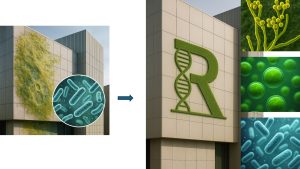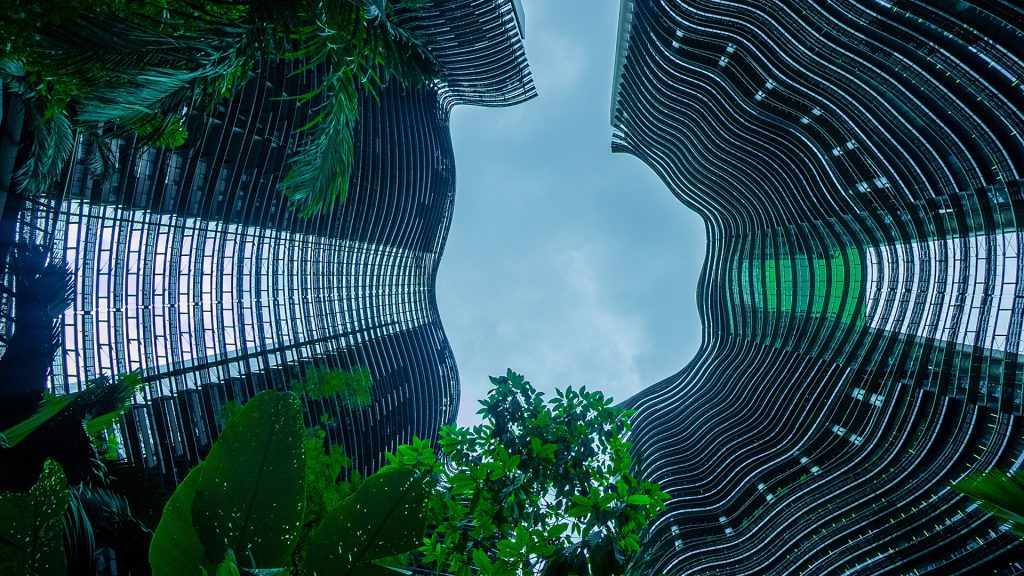REMEDY revolutionizes architecture with living microbial tattoos, transforming buildings into responsive, sustainable ecosystems that promote health and resilience.
The REMEDY project pioneers an innovative approach to architecture. We bring together microbiology, biotechnology, materials science and design to integrate a vision of living, responsive and sustainable buildings. REMEDY offers a revolutionary concept. Archibiome tattoos are a type of artificial microbial ink that can be used to decorate, protect, and heal buildings as well as probiotic skin care to revitalize the human body. Tattoo techniques provide more than just aesthetic or functional improvements. It promotes probiotic architecture, where buildings are no longer inert structures but dynamic ecosystems that contribute to the health, resilience and well-being of the environment.
Innovative concept: arch biome tattoo
Traditional building materials are static. Once constructed, they gradually deteriorate due to the effects of weather, pollution, and microorganisms. The REMEDY project changes this paradigm by designing engineered biomaterials (ELMs) that are self-sustaining, self-healing, and ecologically beneficial. Archibiome Tattoo allows for high-resolution decoration and functionalization of both new and existing buildings. Customized microbial inks allow architects and designers to print patterns directly onto surfaces. These living inks contain engineered consortia of microorganisms that work symbiotically to perform useful functions. Similar to probiotics that promote human health, these microbial inks promote the health of buildings and their surrounding environments. You can customize it to:
Sequester carbon and contribute to climate change mitigation. It produces oxygen and improves local air quality. It breaks down pollutants and enables biological remediation of urban environments. It resists pathogenic microorganisms and acts as a living antibacterial layer. Adapts to environmental conditions and maintains structural and biological balance.
Through the creation of autopoietic surfaces, this approach introduces life as a material property and redefines what it means to design and experience architecture.
From microbiology to architecture: an interdisciplinary vision
REMEDY’s ambitions extend beyond innovation in materials science. We aim to build a bridge between life sciences and the built environment. To achieve this, the consortium will combine computational biology and experimental biofabrication to enable the creation of truly bespoke and intelligent materials that can evolve with their environment. This powerful combination of computational biology and experimental manufacturing allows REMEDY to create truly bespoke and intelligent materials that can evolve with their environment. The architectural meaning of REMEDY is deep.

For centuries, microorganisms have been considered a threat to buildings, causing decay, pollution, and disease. The REMEDY consortium challenges this perception by advancing the idea of microbial integration in architecture and reframing microbes as allies in creating healthier, more sustainable spaces. This project introduces metabolic thinking to the circular building industry by integrating living microbial systems into architecture. Buildings may one day function like living organisms, breathing, regenerating, and interacting with their environments in beneficial ways. This microbial revolution will also redefine the life cycle of materials. Instead of passive, energy-intensive materials that degrade over time, the project envisions active, renewable surfaces that capture carbon, degrade pollutants, and even contribute to urban biodiversity. The concept of probiotic architecture, which first appeared at the intersection of ecology and design, is materialized through REMEDY’s living ink in an architectural context.
Consortium supporting REMEDY
REMEDY’s strength lies in its interdisciplinary and international collaboration. The consortium brings together six partners from four European countries: Slovenia, Austria, the Netherlands and Slovakia, integrating complementary expertise across science, technology and industry. The partnership includes Primorska University (coordinator), University of Ljubljana, Graz University of Technology, TIGER Coatings, Xylotrade BV, and Qres Technologies. Together, these partners form a synergistic ecosystem that can move from concept to prototype, and from scientific insight to concrete architectural solutions.
Part of the EIC Pathfinder Engineered Living Materials portfolio
REMEDY is part of the EIC Pathfinder Portfolio of Engineered Living Materials, a visionary initiative of the European Innovation Council (EIC). EIC supports the development of new technologies and platforms that enable the creation of living materials with programmable functionality, dynamic behavior, and adaptability. REMEDY is fully aligned with these goals and advances the frontiers of sustainable materials science. The inclusion of this project in the ELM portfolio not only demonstrates its scientific ambition, but also positions it within a broader European network of researchers and innovators working towards a common vision of sustainable biofabrication. Additionally, REMEDY secured an EIC Booster Grant to further support integration and collaboration within this growing community of ELM innovators. This funding strengthens the project’s potential to translate laboratory research into deployable real-world applications in architecture and the building industry.
A living future of materials and design
REMEDY rethinks the way we design, build and inhabit environments. The result will be not only new materials, but a new design philosophy that sees architecture as an evolving, living interface between humans, nature, and technology. Future buildings could have layers of living microorganisms that purify the air, produce oxygen, and adjust their color and texture depending on light and humidity. Such advances have the potential to fundamentally change our relationship with the built environment, making cities more resilient, regenerative, and symbiotic. REMEDY’s interdisciplinary approach exemplifies how European research and innovation can lead global change. By combining microbiology and architecture, computing and manufacturing, and ecology and engineering, REMEDY embodies the future of living design.
For more information about REMEDY, please visit the project website. Also, follow us on LinkedIn to stay up to date.
Acknowledgment

This research received funding from the European Union’s Horizon Europe research and innovation program under grant agreement number 101185862. However, the views and opinions expressed are those of the authors alone and do not necessarily reflect those of the European Union or the European Innovation Council and Small and Medium Enterprises Executive Agency (EISMEA). Neither the European Union nor the licensing authorities can be held responsible for them. The REMEDY project has received funding from the European Union’s Horizon Europe program through the BOOST initiative under grant agreement No 101192038.
This article will also be published in the quarterly magazine issue 24.
Source link

